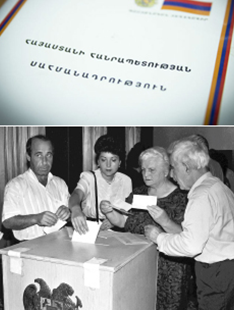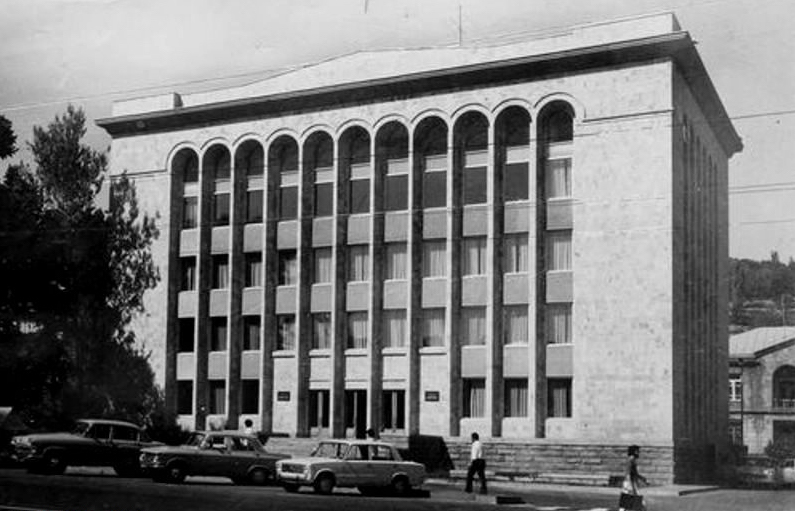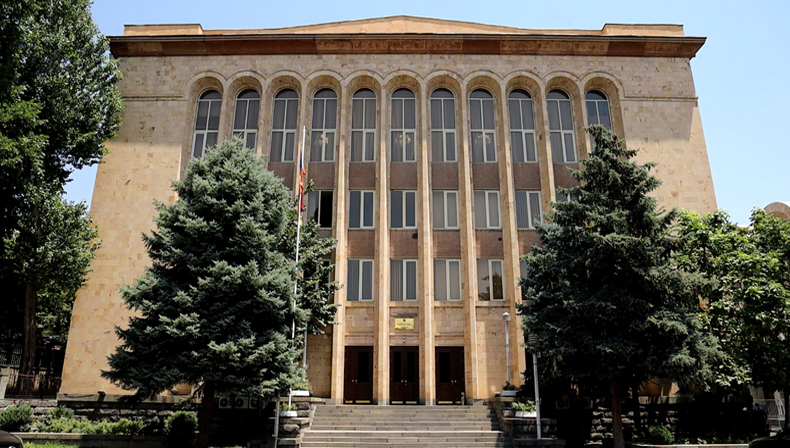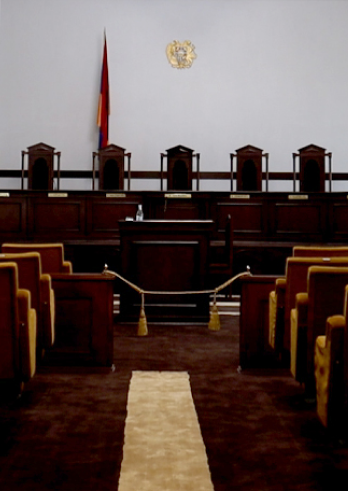About the Constitutional Court
At the same time, while ensuring the supremacy of the Constitution, the Constitutional Court shall, within the scope of its powers, settle disputes arising between constitutional bodies with respect to the constitutional powers thereof, as well as the High Court settles disputes related to the decisions adopted upon the results of a referendum, those of the elections of the National Assembly and the President of the Republic. Within the scopes of its other powers, the Constitutional Court shall, prior to the ratification of an international treaty, determine the compliance of the commitments enshrined therein with the Constitution.
The Constitutional Court shall perform its functions solely on the basis of the submitted applications. Articles 168 and 169 of the Constitution of the Republic of Armenia, as well as the Constitutional Law on the Constitutional Court, stipulate in detail the full scope of powers of the High Court, the list of entities having the competence to apply to the Court, as well as the procedures and time limits within which the relevant applications should be submitted to the Constitutional Court. You can find more information in regard to the powers, activities, structure, and the Staff of the Constitutional Court in the relevant sections of the official website of the Court.
ANTHEM
The peculiarity of the anthem is that it is an instrumental piece without lyrics and it does not repeat the musical theme from verse to verse, and presents musical instrumental arrangement.
The anthem was adopted in 2006, on the occasion of the 10thAnniversary of Founding of the Constitutional Court of the Republic of Armenia.
 JUSTICES
JUSTICES
A lawyer with higher education, having attained the age of forty, holding citizenship of only the Republic of Armenia, having the right of suffrage, with high professional qualities and at least fifteen years of professional work experience may be elected as a justice of the Constitutional Court. The justice of the Constitutional Court may not hold membership in or be a founder of any political party, hold a position in a political party, deliver speeches on behalf of the political party, or otherwise engage in political activities. The justice of the Constitutional Court shall exercise political restraint and neutrality in public speeches and under any other circumstances. The regulations, prescribed by the law for public servants with regard to entrepreneurial activities shall apply to the justice of the Constitutional Court.
 HISTORY
HISTORY
The Constitutional Court established effective working contacts with the Venice Commission of the Council of Europe, as well as with the newly formed national bodies of constitutional oversight of the Eastern European states. In the social and legal life of Armenia, the amendments to the Constitution adopted by the national referendum on 27 November 2005 were an important milestone for the Constitutional Court, which directly referred to the system of constitutional justice. As a result of these amendments, the scope of entities entitled to apply to the Constitutional Court significantly expanded, the scope of issues subject to constitutional control also expanded, and as an innovation, the institution of individual constitutional complaint was introduced, within the framework of which the citizens may submit an application to the Constitutional Court on a specific case, where the final act of the court is available, all domestic judicial remedies have been exhausted, and may challenge the constitutionality of the relevant provision of the law applied against him or her with that act. The aforementioned amendments and innovations introduced to the Basic Law in fact caused the necessity to fundamentally revisit the Law on the Constitutional Court.
The amended law entered into force on 1 July 2006, and before that, it was the subject of in-depth research by the Venice Commission of the Council of Europe. Based on the requirements of the Law, the Constitutional Court subsequently adopted its Rules of Procedure, which systematized the procedure for organizing the submission of individual complaints and the procedures of preliminary examination; moreover, the specifics of judicial service at the Constitutional Court were established. In the course of the next decade, namely from 2005 to 2015, the Constitutional Court, while exercising its new powers, consistently strengthened its role in the domestic affairs of Armenia, and many legal standings of the High Court established new legal guidelines and contributed to the implementation of relevant legislative amendments. The given decade was also marked by the rapid growth of international engagements of the High Court, which made the Constitutional Court one of the most recognized and progressive courts in the post-Soviet space and in Eastern Europe. In this context, the annual Yerevan International Conferences co-hosted with the Venice Commission of the Council of Europe played a prominent role and made the City of Yerevan one of the most recognized platforms for discussing the contemporary and urging issues in the fields of constitutional justice, human rights, and fundamental freedoms. On the other hand, in 2013-2015, a new package of constitutional amendments was discussed in Armenia, as a result of which, following the nationwide referendum held on 5 December 2015, the new constitutional amendments were adopted.
The given amendments significantly expanded the powers of the Constitutional Court, a new procedure for the election of the President and Vice-President was introduced that would contribute to the enhancement of the institutional independence of the High Court. The given amendments resulted not only in clarification of the previous powers of the Constitutional Court, but they also endowed the High Court with the new functions, in particular, the Constitutional Court has the power to resolve disputes arising between constitutional bodies with respect to their constitutional powers. At the same time, as a result of new amendments to the Constitution, it has been stipulated that the justices of the Constitutional Court shall be elected by the National Assembly for a term of twelve years, by at least three-fifths of votes of the total number of Deputies. The Constitutional Court shall be composed of nine justices, of whom three justices shall be elected upon recommendation of the President of the Republic, three justices upon recommendation of the Government, and three justices upon recommendation of the General Assembly of Judges. The General Assembly of Judges may nominate only judges.
The same person may be elected as a justice of the Constitutional Court only once. As a guarantee of ensuring institutional independence and a mechanism for guaranteeing political independence, it was established by the new amendments to the Constitution that the Constitutional Court shall elect the President and Vice-President of the Constitutional Court from among its members for a term of six years, without the right to be re-elected. On 22 June 2020, the National Assembly of the Republic of Armenia adopted amendments to Article 213 of the Constitution, as a result of which Parts 1 and 2 of Article 166 of the Constitution, concerning the formation of the Constitutional Court, were fully implemented, thus equalizing the status of the justices of the Constitutional Court and their terms in office, as well as providing an opportunity to elect the President of the Constitutional Court from among the composition of the Constitutional Court. Moreover, as a factor in increasing the democratic legitimacy of the Constitutional Court, the amendment ensured the engagement of all constitutionally prescribed bodies participating in the process of filling the composition of the Constitutional Court.
 CHRONOLOGY
CHRONOLOGY
- 1995
- 1996
- 1997
- 2000
- 2005
- 2009
- 2013
- 2015
- 2018
- 2020

 ADMINISTRATIVE BUILDING
ADMINISTRATIVE BUILDING
The Library of the Constitutional Court is intended not only for the Justices and Staff of the Constitutional Court, but it also serves as a resource center for practitioners, lawyers, law students, postgraduates, researchers and ordinary citizens. The courtroom named after Shahamir and Hakob Shahamiryans with 120 seats is located on the fourth floor of the administrative compound. At the demonstration areas, which are situated in different sections of the administrative compound, the visitors can observe works by the famous Armenian artists, which are provided by the National Gallery of Armenia and deposited at the Constitutional Court.



The website of the Constitutional Court of the Republic of Armenia has been created as part of the Partnership for Good Governance (PGG II) Project ''Support to the judicial reform – enhancing the independence and professionalism of the judiciary in Armenia'' co-funded by the European Union and the Council of Europe. The views expressed herein can in no way be taken to reflect the official opinion of either party.

The upgrade of the official website of the Constitutional Court of the Republic of Armenia is made possible by the support of the American People through the United States Agency for International Development (USAID) as a part of the USAID/Armenia Justice Sector Support Project. The content of this website is the sole responsibility of the Constitutional Court and does not necessarily reflect the views of USAID or the United States Government.







